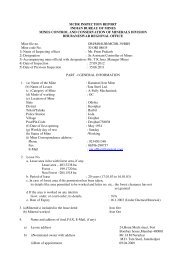Market Survey on Copper - Indian Bureau of Mines
Market Survey on Copper - Indian Bureau of Mines
Market Survey on Copper - Indian Bureau of Mines
You also want an ePaper? Increase the reach of your titles
YUMPU automatically turns print PDFs into web optimized ePapers that Google loves.
ladle crane to the Pierce Smith C<strong>on</strong>verter. Furnace oil fired burner maintains<br />
the temperature <strong>of</strong> c<strong>on</strong>verter between two c<strong>on</strong>verter operati<strong>on</strong>s. In c<strong>on</strong>verter,<br />
air is blown through the liquid matte at a pressure through side blown tuyers and<br />
quartz is added as flux, resulting in producti<strong>on</strong> <strong>of</strong> blister copper (98%) and slag<br />
(c<strong>on</strong>taining about 5% Cu).<br />
The slag from flash smelting furnace and c<strong>on</strong>verters is treated in a sub-merged<br />
arc slag cleaning furnace for reducing copper c<strong>on</strong>tent in discard slag to below<br />
0.7% Cu. The slag is allowed to settle in slag cleaning furnace where two<br />
layers <strong>of</strong> molten matte and slag are formed. Matte from slag cleaning furnace is<br />
treated in c<strong>on</strong>verters whereas slag is tapped, granulated and sent to the dump<br />
yard.<br />
Blister copper from c<strong>on</strong>verters is poured into ladles and transferred to anode<br />
furnace by means <strong>of</strong> Electrical Overhead Transport crane for fire refining. Fuel<br />
used for the heating burner in the Anode Furnace is naphtha, which is low<br />
sulphur fuel suitable to maintain the quality <strong>of</strong> refined copper. C<strong>on</strong>trolled air<br />
blowing first oxidises remaining sulphur to remove it as sulphur dioxide.<br />
However, in the process, a part <strong>of</strong> copper is also oxidized, which is reduced<br />
back by reducti<strong>on</strong> with hydrocarb<strong>on</strong>s available from cracking <strong>of</strong> propane<br />
injected under the metal bath. The fire refined copper c<strong>on</strong>taining 99.5% Cu<br />
poured <strong>on</strong> rotating anode casting wheel as anode and dispatched to refinery tank<br />
house for electro-refining to produce copper cathodes. Through this most<br />
efficient process, copper recovery <strong>of</strong> 98.5% and sulphur recovery <strong>of</strong> 95% is<br />
achieved.<br />
Gases rich in sulphur dioxide are processed in Sulphuric Acid Plant (double<br />
c<strong>on</strong>versi<strong>on</strong> double absorpti<strong>on</strong> (DCDA) process) to produce sulphuric acid.<br />
iv) Jhagadia <strong>Copper</strong> Ltd., (Formerly SWIL Ltd.) : SWIL Ltd. has been<br />
renamed as Jhagadia <strong>Copper</strong> Ltd. w.e.f. 05.01.2006. Its smelter is installed at<br />
Jhagadia in Bharuch district <strong>of</strong> Gujarat. It is a scrap based electrolytic smelter<br />
to make cathodes with a capacity <strong>of</strong> 50,000 tpy. The plant has an additi<strong>on</strong>al<br />
capacity <strong>of</strong> 20,000 tpy copper anodes. Out <strong>of</strong> the total capacity, 6000 tpy output<br />
is used for producing wires, strips, etc., 20,000 tpy are exported and 24,000 tpy<br />
are sold in domestic markets. The plant is set up in technical collaborati<strong>on</strong> with<br />
Boliden C<strong>on</strong>tech AB <strong>of</strong> Sweden.<br />
3.3 PRODUCTION<br />
3.3.1 Producti<strong>on</strong> <strong>of</strong> Ore<br />
The history <strong>of</strong> producti<strong>on</strong> <strong>of</strong> base metals including copper is dated back<br />
to ancient times. The presence <strong>of</strong> extensive dumps near the old working, huge<br />
heaps <strong>of</strong> old slag are evidences <strong>of</strong> ancient copper mining in India particularly in<br />
Khetri and Singhbhum are the silent testim<strong>on</strong>ies <strong>of</strong> <strong>on</strong>ce thriving mining<br />
activity. Both opencast and underground methods <strong>of</strong> mining were adopted. The<br />
sulphide ores are very important. The primary mineral chalcopyrite and the<br />
sec<strong>on</strong>dary mineral chalcocite account for li<strong>on</strong>'s share <strong>of</strong> copper producti<strong>on</strong> in<br />
51
















